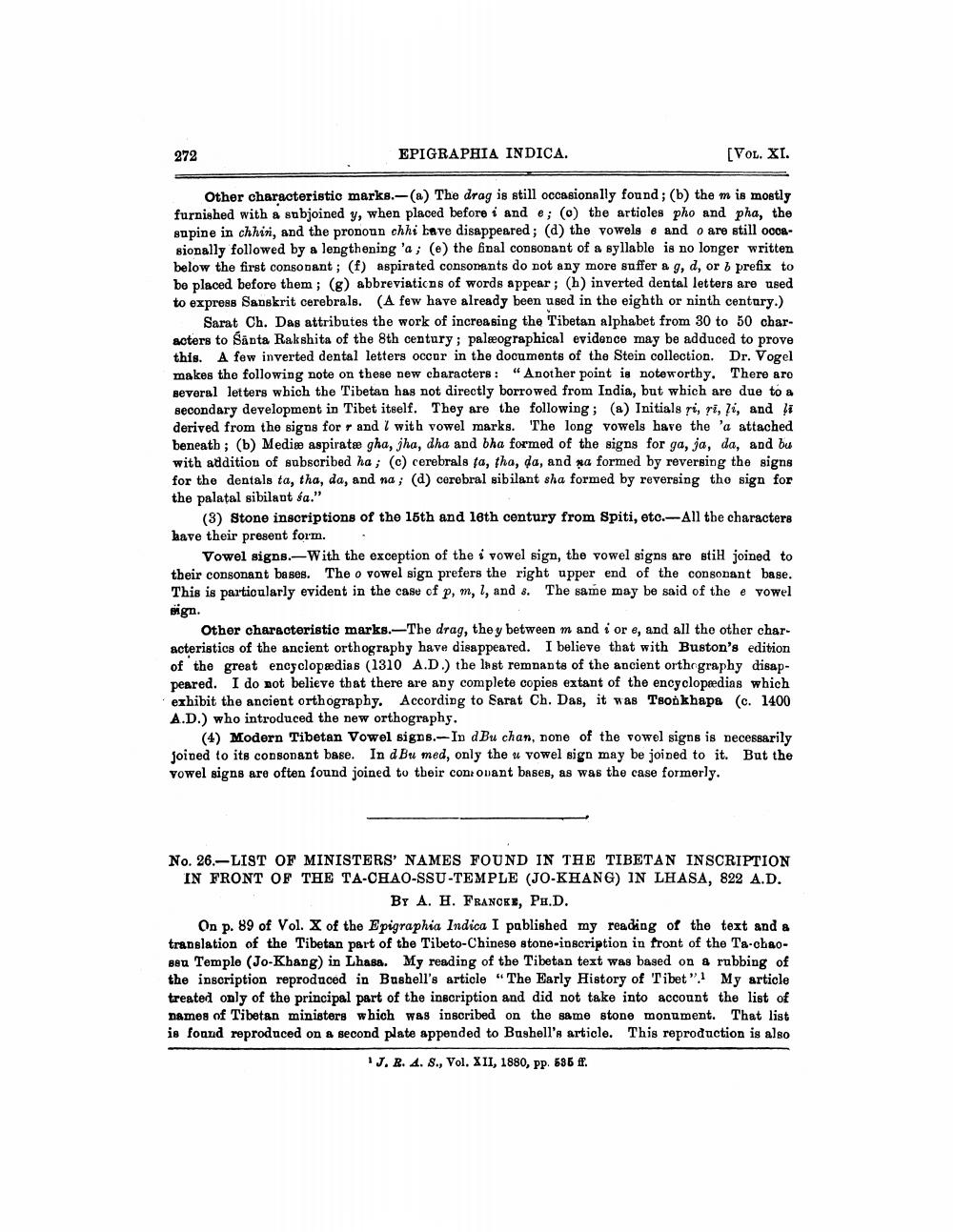________________
272
EPIGRAPHIA INDICA.
[VOL. XI.
Other characteristic marks.-(a) The drag is still occasionally found; (b) the m is mostly furnished with a subjoined y, when placed before i and e; (c) the articles pho and pha, the supine in chhin, and the pronoun chhi bave disappeared; (d) the vowels e and o are still occasionally followed by a lengthening 'a; (e) the final consonant of a syllable is no longer written below the first consonant; (f) aspirated consonants do not any more suffer a g, d, or b prefix to be placed before them; (g) abbreviations of words appear; (h) inverted dental letters are used to express Sanskrit cerebrals. (A few have already been used in the eighth or ninth century.)
Sarat Ch. Das attributes the work of increasing the Tibetan alphabet from 30 to 50 characters to Santa Rakshita of the 8th century; paleographical evidence may be adduced to prove this. A few inverted dental letters occur in the documents of the Stein collection. Dr. Vogel makes the following note on these new characters: "Another point is noteworthy. There are several letters which the Tibetan has not directly borrowed from India, but which are due to a secondary development in Tibet itself. They are the following; (a) Initials ri, ri, li, and li derived from the signs for r and I with vowel marks. The long vowels have the 'a attached beneath; (b) Mediæ aspirate gha, jha, dha and bha formed of the signs for ga, ja, da, and bu with addition of subscribed ha; (c) cerebrals ta, tha, da, and a formed by reversing the signs for the dentals ta, tha, da, and na; (d) cerebral sibilant sha formed by reversing the sign for the palatal sibilant fa."
(3) Stone inscriptions of the 15th and 16th century from Spiti, etc.-All the characters have their present form.
Vowel signs. With the exception of the i vowel sign, the vowel signs are stiH joined to their consonant bases. The o vowel sign prefers the right upper end of the consonant base. This is particularly evident in the case of p, m, 1, and s. The same may be said of the e vowel sign.
Other characteristic marks.-The drag, they between m and i or e, and all the other characteristics of the ancient orthography have disappeared. I believe that with Buston's edition of the great encyclopædias (1310 A.D.) the last remnants of the ancient orthography disappeared. I do not believe that there are any complete copies extant of the encyclopædias which exhibit the ancient orthography. According to Sarat Ch. Das, it was Tsonkhapa (c. 1400 A.D.) who introduced the new orthography.
(4) Modern Tibetan Vowel signs.-In dBu chan, none of the vowel signs is necessarily joined to its consonant base. In dBu med, only the u vowel sign may be joined to it. But the Vowel signs are often found joined to their consonant bases, as was the case formerly.
No. 26.-LIST OF MINISTERS' NAMES FOUND IN THE TIBETAN INSCRIPTION IN FRONT OF THE TA-CHAO-SSU-TEMPLE (JO-KHANG) IN LHASA, 822 A.D. BY A. H. FRANCKE, PH.D.
On p. 89 of Vol. X of the Epigraphia Indica I pablished my reading of the text and a translation of the Tibetan part of the Tibeto-Chinese stone-inscription in front of the Ta-chaoseu Temple (Jo-Khang) in Lhasa. My reading of the Tibetan text was based on a rubbing of the inscription reproduced in Bushell's article "The Early History of Tibet". My article treated only of the principal part of the inscription and did not take into account the list of names of Tibetan ministers which was inscribed on the same stone monument. That list is found reproduced on a second plate appended to Bushell's article. This reproduction is also
1 J. B. 4. S., Vol. XII, 1880, pp. 535 ff.




